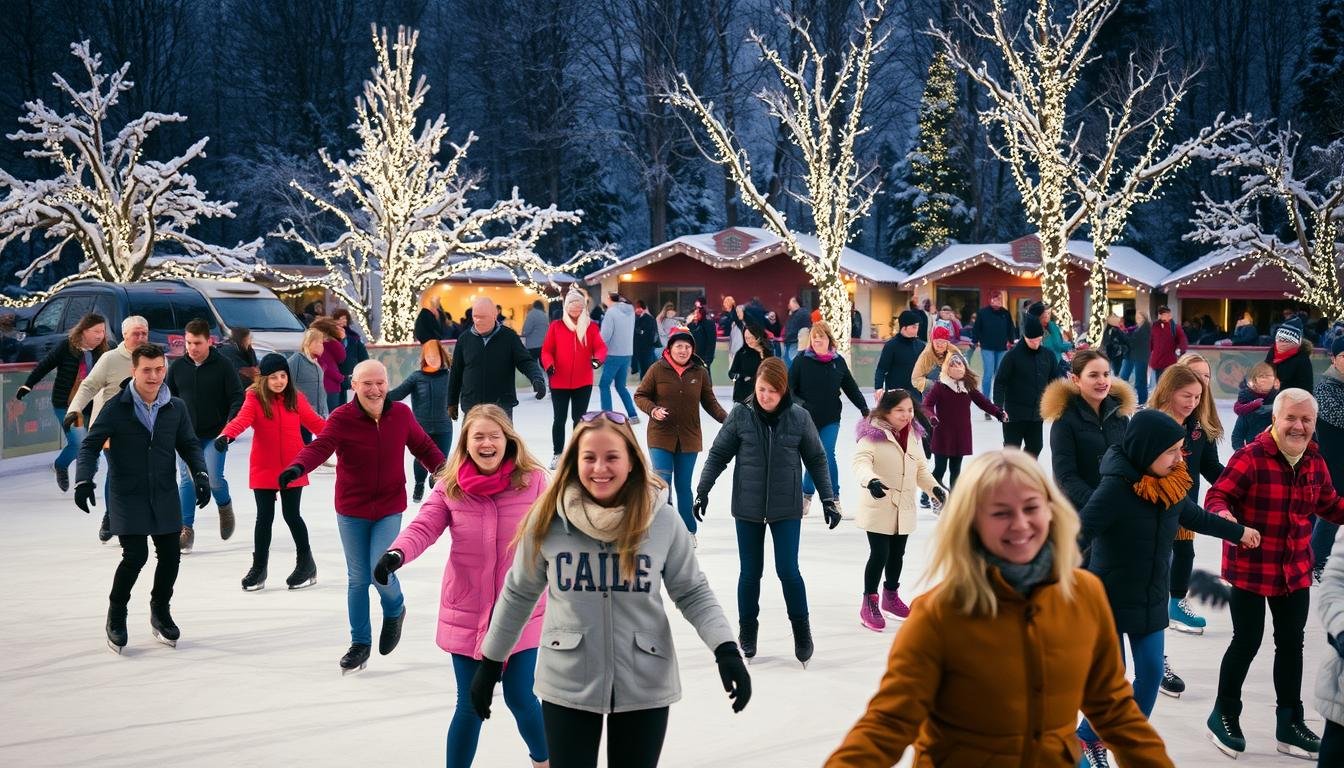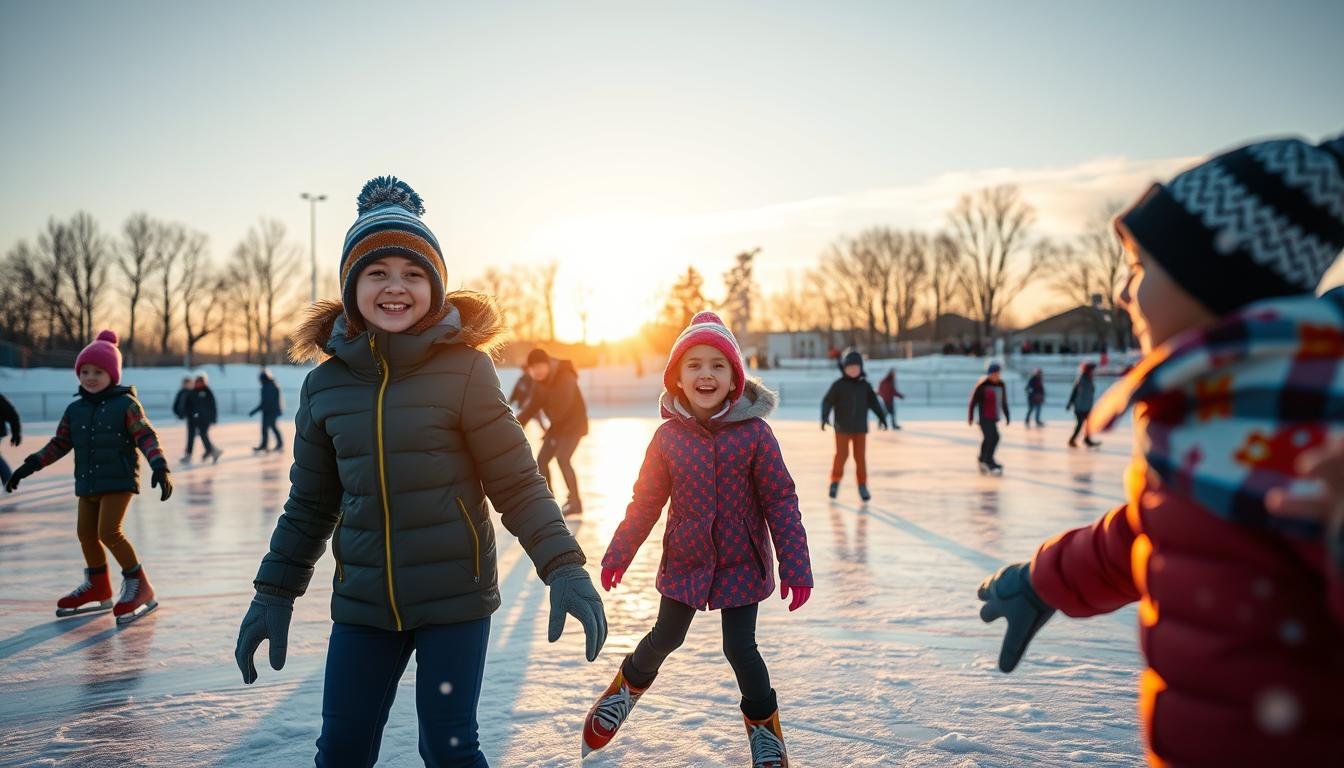Winter brings a chance to try ice skating. This sport mixes grace, fitness, and fun.
Ice skating can make cold weather more exciting. Our guide will help you start with confidence.
Ice skating basics are easy to learn. It’s great for fun or fitness.
Beginners can quickly build skills. Understanding key moves and being patient helps.
We’ll show you how to get started. You’ll learn about gear and basic moves.
Our tips will make you a good skater. Get ready for the thrill of gliding!
Ice skating is fun and good exercise. It helps you grow and feel proud.
Let’s start your skating adventure! You’ll soon be sliding with joy.
Introduction to Ice Skating
Ice skating is a fun winter sport that mixes grace and skill. It involves gliding on ice using skates with sharp blades.
This activity is not just fun. It also offers many health perks that make it a great workout.
There are two main types of ice skating. Figure skating focuses on artistic moves and spins.
Speed skating is all about going fast on an oval track. Athletes push themselves to reach top speeds.
Ice skating helps you use many muscles at once. It improves balance, coordination, and heart health.
You can burn up to 450 calories per hour while skating. This makes it a good way to stay fit in winter.
Both beginners and pros can enjoy this exciting sport. It offers fun for all skill levels.
You can skate at local rinks or watch pro contests. This sport keeps inspiring people of all ages.
Choosing the Right Ice Skates
The right ice skates can make your skating better. Figure skates and hockey skates are popular for beginners.
Figure skates have a longer blade and toe pick. They’re great for artistic moves and spins.
Hockey skates have shorter, curved blades. These allow for quick turns and fast movement.
Skate fitting is key for comfort. Your toes should touch the front without feeling cramped.
Skate shops can help you find your perfect fit. They’ll give advice based on your skills and goals.
Think about your skating style and skill level. Rentals are good for trying different skate types.
Well-fitted skates prevent blisters and improve technique. They also make ice skating more fun.
Preparing for Your First Ice Skating Experience
Careful prep is key for your first ice skating adventure. Wear lightweight, flexible clothes like thermal leggings and a warm sweater.
Safety gear is crucial for beginners. Protect yourself with a helmet, wrist guards, and knee pads.
A pre-skating warm-up prevents muscle strains. Do light stretches for 10-15 minutes, focusing on the legs, ankles, and core.
Dynamic stretches like leg swings help prepare your body. Ankle rotations and gentle lunges are also good options.
Wear thick, warm socks for cushioning and blister prevention. Choose wool or synthetic blend socks to keep your feet dry.
Dress in breathable layers you can easily remove. Rink temps vary, so adaptable clothing ensures comfort throughout skating.
Basic Ice Skating Techniques
Ice skating starts with learning balance and movement. Good body position and weight distribution are key for new skaters.
Stand with feet shoulder-width apart and knees slightly bent. Keep your weight centred over your skates’ middle.
Relax your arms and hold them out for extra stability. This helps you stay steady on the ice.
Stopping is a must-know skill for beginners. The snowplough stop is easy and works well.
Point your toes in and push your heels out. This makes a wedge shape with your skates.
Press the inside edges of your blades into the ice. This will slow you down and stop you.
Practice gliding by pushing off gently with each foot. Start small and build up your confidence.
Keep your head up and look forward. Stay relaxed as you skate.
Don’t worry if you wobble at first. Balance gets better with practice.
Each time on the ice, you’ll feel more at ease. Your skating will improve with time.
Navigating the Ice Rink
Ice rink rules keep everyone safe. Skaters must move counterclockwise and be aware of others.
Learning to fall safely on ice prevents injuries. Bend your knees and fall forward onto your hands.
Keep your head up when falling. Avoid landing on your wrists or tailbone.
Protective gear like helmets adds extra safety, and padded clothing can also help protect you.
Mastering ice skating turns is key. Start with basic two-foot turns near the rink’s edge.
Practice shifting your weight and rotating gently. Use the wall for support as you learn.
Progress to one-foot turns as you improve. These turns need more balance and control.
Watch skilled skaters to learn new techniques. Many rinks offer beginner sessions or lessons.
Stay relaxed on the ice. Keep your centre of gravity low.
Make smooth, controlled movements. Practice often to build your skills.
Don’t worry if you stumble at first. You’ll get better each time you skate.
Common Mistakes for Beginners to Avoid
Ice skating mistakes can quickly discourage new skaters. Understanding common errors helps beginners build confidence and improve their skills.
Most novice skaters struggle with maintaining proper ice skating balance, which is crucial for safe and enjoyable skating.
Avoid looking down while skating. Keeping your head up helps maintain balance and prevents unexpected falls.
Focus on a point ahead of you. This allows your body to align and move forward smoothly naturally.
Tension is another critical mistake that new skaters make. Stiff legs and rigid posture can make ice skating challenging.
Practice relaxed movements and bend your knees slightly. This improves stability and allows for more fluid motion across the ice.
Beginners often lean back, disrupting their centre of gravity. Keep your body weight slightly forward, with knees bent and arms relaxed.
This position helps maintain better control and reduces falling risks. Practice is key to overcoming these common ice skating mistakes.
Start with small goals and take lessons from professional instructors. Be patient with yourself as you learn and improve.
Remember, every expert skater was once a beginner. They learned through practice and never giving up.
Learning Resources for Ice Skating
Ice skating tutorials are great for beginners. Online videos break down complex moves into manageable steps.
Local ice skating classes offer hands-on learning. Instructors give personal tips and boost your confidence on ice.
Ice skating books can be helpful for self-study. Look for ones with clear pictures and expert advice.
Digital platforms make learning ice skating fun. Websites and apps offer interactive lessons you can do at home.
Try using different ways to learn. Mix online lessons with classes and books for the best results.
Practice often and be patient. These are key to becoming a good ice skater.
Ice Skating as a Fun Activity
Ice skating is more than a winter sport. It’s an exciting social experience that brings people together.
Community ice rinks are perfect playgrounds for shared adventures. Friends and families can create lasting memories on the ice.
Outdoor skating is a magical way to enjoy winter’s beauty. Parks and community centres often have seasonal skating areas.
These outdoor venues become social hubs for all ages. People gather to experience the joy of gliding together.
Group lessons can make skating fun and supportive. Many rinks offer classes to help newcomers build confidence.
The social aspect creates a warm, encouraging environment. Learning becomes an enjoyable shared journey for everyone.
Skating is a great way to stay active in winter. It helps people connect with others and enjoy physical activity.
Group skating is versatile, and it’s an exciting option for everyone to enjoy, from date nights to family outings.
Maintaining Your Ice Skates and Safety
Ice skate maintenance is crucial for preserving your investment. Regular skate inspection helps prevent unexpected equipment failures.
Clean your blades after each use with a soft cloth. This removes moisture and prevents rust formation.
Dry your skates entirely after each use. Pay special attention to the blades and boot edges.
Store ice skates in a cool, dry area. Keep them away from direct heat sources.
Use blade guards when walking off the ice. This protects the sharp edges from damage on hard surfaces.
Check your blades regularly for any signs of wear. Look for nicks, rust, or uneven edges.
Get professional sharpening every 15-20 hours of skating. This helps maintain optimal blade condition.
Replace blade guards and laces when they show significant wear. This prevents potential accidents.
Invest in a protective skate bag. It shields your equipment from environmental damage.
Keep your skates in a well-ventilated area. Maintain consistent temperature to prevent leather degradation and rust.
FAQ
What equipment do I need to start ice skating?
You’ll need well-fitting ice skates and warm, comfy clothes. Thick socks are a must. Safety gear like helmets and pads are optional.
Choose skates with good ankle support. They should fit snugly without being too tight.
Is ice skating difficult for beginners?
Ice skating can be tricky at first. But most people can learn with practice.
Take lessons and use the rink’s support rail. Focus on balance, and don’t worry about falling.
How do I stop safely while ice skating?
The snowplough stop is excellent for beginners. Point your toes in and push your heels out.
Bend your knees to create friction on the ice. This will slow you down safely.
What should I wear for ice skating?
Wear comfy, flexible layers that let you move freely. Choose thermal or moisture-wicking base layers.
Add a light jacket and comfy pants. Don’t forget warm socks and gloves.
How can I improve my balance on the ice?
Keep your knees bent and your weight centred. Start with small steps on the ice.
Try yoga and balance exercises off the ice. These can help your stability, too.
Are ice skating lessons worth it for beginners?
Yes! Lessons teach proper techniques and boost confidence. Instructors give personalized tips and safety advice.
You’ll learn faster with a pro than on your own.
How do I choose the right ice skates?
Pick skates based on your skating style. Figure skates are for artistic moves.
Hockey skates work for faster skating. Visit a skate shop for expert help.
Is ice skating a good form of exercise?
Ice skating is a great full-body workout. It boosts heart health and leg strength.
It’s fun for all ages and fitness levels. Skating burns calories while improving balance.
How can I prevent falling while ice skating?
Keep your knees bent and move slowly. Stretch your arms out for balance.
Look ahead, not at your feet. If you wobble, try to fall forward safely.
Can children learn to ice skate?
Yes! Kids often learn to skate quickly. Many rinks offer special classes for children.
Use safety gear and get pro lessons. Lots of praise helps build confidence.
you may also read: How to Quit a Job Gracefully in 5 Easy Steps

